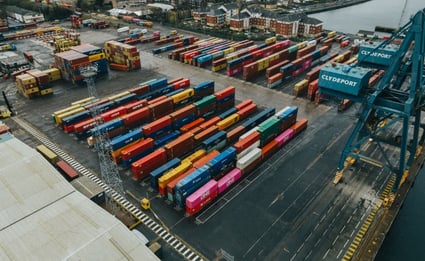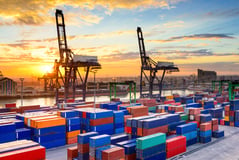The Importance of Forecasting in Logistics Planning
Jesse Kelber - November 07, 2019

Of all the stages of the supply chain, logistics often gets a bad rap. This appears to be largely due to a combination of the seeming unpredictability of the unknowns like weather patterns and fuel costs; and the skyrocketing costs associated with last-mile delivery in recent years. This potent combo makes it all the more unexpected that logistics is also quite often overlooked when it comes to applying learnings from demand forecasting. The predictive analytics used by demand forecasting solutions takes historical data, runs it through advanced AI algorithms and generates predictions for demand in a specified upcoming time period. That sounds pretty useful for cutting logistics costs and leveling out some of the uncertainty that’s endemic to this sector, doesn’t it?
Before we dive in, what exactly do we mean by demand forecasting, and how precisely do we imagine it being useful to logistics planners? Demand forecasting, at its simplest level, is looking at historical customer demand data, combining it with predictions for future buying patterns, and generating a forecast of how much product you need to have available at a given time and place. The uses in terms of logistics planning are why we’re here today. There are five primary areas where solid demand forecasting can help you plan for the seemingly unexpected, cut costs, and streamline your logistics planning efforts: load distribution, flexibility in case of disruptions, seasonality, inventory costs, and inbound logistics planning.
Load Distribution: Forecasting Pallet Space Needs
Demand forecasting tells you how much product you can expect to need in a given place, at a given time. By extension, that means it’s also a great way to know how much product you’ll be needing to ship to those given places at those given times. And if you also know what your regular demand looks like, you can combine all of that knowledge and use available pallet space in the off-season to pre-load strategic locations with the supply they’ll need when the spike hits. Knowing what production looks like in the coming months enables logistics planners to better distribute inventory across facilities by filling up unused pallet space when possible. Thus ensuring the right product is where it needs to be to meet customer demand.
Logistics Flexibility When it Matters
Disruptions happen. There’s simply no way to know everything with enough warning to head off the occasional shipment reroute, or work around an unexpected fuel shortage. That said, one result of better planning and inventory distribution is that when a disruption does occur, you’ll have product strategically located to pick up the slack and replace stock that gets depleted as a result of a natural disaster (or whatever event impacted the supply chain). This kind of flexibility can do wonders when it comes to keeping the costs of these disruptions in check since you can shuffle existing stock as needed without incurring any long-haul expenses and without losing any existing warehouse space. You know that one cousin we all have, the one who keeps a cooler of beer next to his hammock all summer? When his relaxation is disrupted by the emptying of a bottle, he’s got a resupply handy, having already restocked that cooler. No need to disturb his rest getting out of the hammock, trekking into the kitchen and all the way back out to re-settle in the shade.
Seasonality and its Effect on Logistics Forecasting
Another of the often overlooked areas of logistics and forecasting is the impact of seasonal demand fluctuations. Around the holidays, everybody seems to be shipping everything to everybody else. Then, during late summer, there seem to be near-empty trucks crisscrossing the continent. That extra space is your ticket to inventory redistribution so you can be ready for not only the demand spike to come but also the impending spike in transportation costs associated with that lack of available space. Whatever space there is to find during the holidays goes for a premium, after all, so having your inventory well placed ahead of time will get you through without weathering any hits to your bottom line. And by planning in advance, based on the predictive analytics used in demand forecasting, you can rest assured that the artificial intelligence that created the forecast took into account all the available data in telling you when to ship that product and the most strategic place to store it.
Inventory Costs: A Hidden Killer of Logistics Budgets
How many warehouses does your inventory stop off at on the journey to its final destination? We’ve already talked a bit about inventory shuffling and how using demand forecasting to adjust what you ship where, when can have big impacts on your logistics budget. There is one piece we haven’t touched on, however; the fact that you can often drastically cut or even eliminate these brief stop-overs. Most of the time, the stop is necessary to shift pallets between trucks, or to store partial shipments while awaiting the arrival of the remainder of the order before the entire thing is repacked for final delivery. If you know to expect big orders in one location in the coming months, you can take the opportunity to slowly stock up on the right items in a local warehouse so when the order comes in, you’re ready to go with no further shuffling needed.
Don’t Forget About Inbound Logistics
Quality demand forecasts, generated by advanced analytics and AI-powered software, can assist the inbound side of your logistics operation just as well as the outbound side. Knowing in advance about production runs means your planners can know how much of what raw materials will be needed and at which facilities. This advanced knowledge means they can better distribute material orders to cut the costs of duplicate orders or emergency resupplies due to insufficient materials on hand.
The bottom line, as with so much in the logistics world, is keeping the customer satisfied. The ability to know how much of what will be needed, and when and where that need will be, is crucial to that goal. The increased accuracy of your shipping, inventory, and distribution all means better OTD numbers. And that’s the logistical key to happy, repeat customers.
If you want to learn more get your Guide to Logistics 4.0
In this Guide you will learn:
-
Why a strategic process in transportation planning is a top priority for digitalization
-
What megatrends will increase supply chain volatility
-
How to manage it
LATEST POSTS
- Understand Circular Economy in The Manufacturing Industry
- How Can Industry 4.0 IT Integration Be Achieved Smoothly?
- The Significance of Order Sequencing in Discrete Manufacturing
- How to improve your Supply Chain Management: The Power of Control Towers
- Optimizing Human Resource Scheduling in Manufacturing: A Technological Approach



